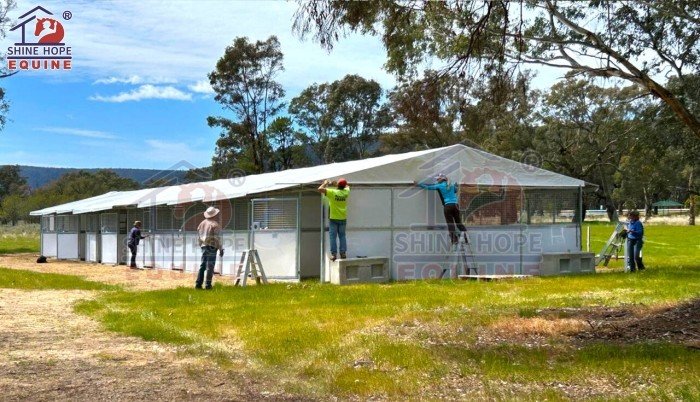Horses bring joy, physical activity, and emotional connection to their owners—but caring for them also requires careful planning, time, and money. One of the biggest decisions new owners face is: board your horse at a stable or keep it at home? To help you choose, we’re breaking down the essential costs, daily care needs, and key factors you need to know before taking on horse ownership.

Caring for a horse isn’t cheap, but knowing the numbers upfront helps you budget. Here’s what you need to expect.
According to finance site Money Crashers, basic horse care costs $200–$325 per month, or an average of $3,876 per year. This includes core expenses like:
Feed (grain, hay, pasture)
Supplements (salts, minerals)
Routine care (farrier visits, vet checkups)
Bedding, utilities, and tack supplies
Insurance and riding lessons (if needed)
Costs change drastically depending on where you keep your horse:
Boarding: Prices vary by location. It can cost $600/month near Portland, OR, but jump to $1,300/month in wealthy areas of New York. Urban and suburban stables are almost always more expensive.
Home housing: Cheaper in monthly fees, but requires upfront work (like maintaining land or a barn) and daily physical labor—both of which have hidden costs (e.g., manure removal, barn repairs).
Buy high-quality but affordable hay (shop around local farms).
Learn basic hoof trimming to reduce farrier visits.
Create a detailed annual budget before buying a horse to avoid surprise expenses.
Beyond costs, horses have daily needs that keep them healthy and happy. Skipping these can lead to injury or illness.
Every horse is different, but all rely on roughage (hay or pasture) for calories. Here’s the general rule:
Feed 1% of your horse’s body weight in hay/pasture daily.
A 1,000-pound horse eats 20–25 pounds of food daily (hay + grain, if needed).
Horses with unlimited access to good pasture can eat up to 25 pounds of grass daily.
Hay is a great alternative to grass, but make sure it’s suited to your horse’s age and activity level.
Horses are natural grazers—they need to move to stay healthy.
Pasture/paddock horses: If they’re free to roam most of the day, 15–20 minutes of focused exercise (e.g., walking, trotting) is enough.
Stabled horses: Need at least 30 minutes of daily exercise (more if they’re used for riding or work).
Customize workouts: Match exercise to your horse’s use. For trail horses, add speed intervals to build stamina. Always be consistent—skipping workouts can lead to injury when you restart.
Grooming is non-negotiable—it keeps your horse healthy and helps you spot issues early.
Daily tasks: Brush to remove dirt (prevents saddle sores), check for cuts/irritations, and clean hooves. Even if you don’t ride, stick to a schedule.
Curry comb or grooming mitt
Stiff-bristled body brush
Mane and tail comb
Soft-bristled finishing brush
Hoof pick
Clean sponge/soft cloth
Optional: Grooming spray, hoof ointment, scissors
Check hooves: Use a hoof pick to remove dirt, rocks, or debris. Look for cracks—these can cause pain or infection.
Curry comb: Brush from neck to rear to loosen dirt and boost circulation (releases natural oils for a shiny coat).
Body brush: Use quick flicks to remove loose hair/dirt.
Finishing brush: Long strokes from neck to rear (and around the face) to dust away remaining particles.
Mane/tail: Comb small sections from bottom to top to avoid knots—work up to brushing from top to bottom.
If you don’t have space at home, boarding is a popular choice—but it’s not one-size-fits-all.
What it is: You pay a portion of the board to use the horse for a set number of hours/week (at specific times).
Key notes: You do NOT own the horse. You may also be responsible for vet/farrier fees.
Pros: Cheaper than full boarding.
Cons: Limited access to the horse; no ownership rights.
What it is: You pay more for unlimited access to your horse, plus grooming, feeding, and care from stable staff.
Key notes: Costs depend on location, amenities (e.g., arena access, lessons), and number of horses.
Pros: Less daily work for you; professional care.
Cons: Expensive (can exceed $700/month in urban areas). Risk of neglect—always check on your horse frequently to ensure it’s healthy.
Location (urban areas = higher prices).
Amenities (lessons, arenas, trails add cost).
Competition (popular stables charge more).
Discounts: Some stables offer reduced rates if you do labor (e.g., mucking stalls).
If you want full control, housing your horse at home is an option—but it requires space and preparation.
Minimum: 1 acre per horse (with excellent management, e.g., rotating pastures to prevent overgrazing).
Recommended: 2 acres per horse (gives more room to graze and move).
Variables: Number of horses, horse size, and how you manage pastures (e.g., adding hay in winter).
Existing barn: Inspect for safety (e.g., sturdy walls, good ventilation). The minimum size for a riding horse’s stall is 10’x10’ to 12’x12’—larger stalls are needed for draft breeds or pregnant mares.
Monthly expenses: Hay, feed, bedding, manure removal, barn utilities (water, electricity). If you have a mortgage on the property, add that too.
Total monthly cost: $300–$400 on average.
Horse ownership is rewarding, but it’s not a decision to rush. Before bringing a horse home, calculate costs, decide on boarding vs. home housing, and make sure you have time for daily care (feeding, exercise, grooming).
By planning ahead, you’ll ensure your horse stays healthy—and you’ll avoid the stress of unexpected expenses or unmet needs.
Would you like me to create a printable monthly budget tracker for horse care, or a checklist to evaluate if a boarding stable is right for you? Just let me know which would be more helpful.
Email: info@shinehopeequine.com
Phone: +8613869898222.(24 hours).